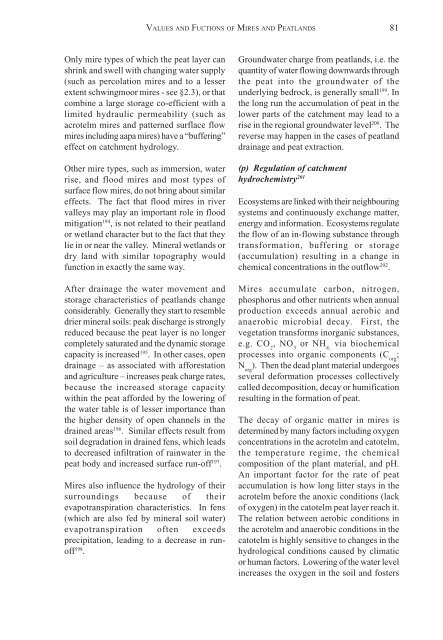wise use of mires and peatlands - Peatland Ecology Research Group
wise use of mires and peatlands - Peatland Ecology Research Group
wise use of mires and peatlands - Peatland Ecology Research Group
Create successful ePaper yourself
Turn your PDF publications into a flip-book with our unique Google optimized e-Paper software.
VALUES AND FUCTIONS OF MIRES AND PEATLANDS81Only mire types <strong>of</strong> which the peat layer canshrink <strong>and</strong> swell with changing water supply(such as percolation <strong>mires</strong> <strong>and</strong> to a lesserextent schwingmoor <strong>mires</strong> - see §2.3), or thatcombine a large storage co-efficient with alimited hydraulic permeability (such asacrotelm <strong>mires</strong> <strong>and</strong> patterned surflace flow<strong>mires</strong> including aapa <strong>mires</strong>) have a “buffering”effect on catchment hydrology.Other mire types, such as immersion, waterrise, <strong>and</strong> flood <strong>mires</strong> <strong>and</strong> most types <strong>of</strong>surface flow <strong>mires</strong>, do not bring about similareffects. The fact that flood <strong>mires</strong> in rivervalleys may play an important role in floodmitigation 194 , is not related to their peatl<strong>and</strong>or wetl<strong>and</strong> character but to the fact that theylie in or near the valley. Mineral wetl<strong>and</strong>s ordry l<strong>and</strong> with similar topography wouldfunction in exactly the same way.After drainage the water movement <strong>and</strong>storage characteristics <strong>of</strong> peatl<strong>and</strong>s changeconsiderably. Generally they start to resembledrier mineral soils: peak discharge is stronglyreduced beca<strong>use</strong> the peat layer is no longercompletely saturated <strong>and</strong> the dynamic storagecapacity is increased 195 . In other cases, opendrainage – as associated with afforestation<strong>and</strong> agriculture – increases peak charge rates,beca<strong>use</strong> the increased storage capacitywithin the peat afforded by the lowering <strong>of</strong>the water table is <strong>of</strong> lesser importance thanthe higher density <strong>of</strong> open channels in thedrained areas 196 . Similar effects result fromsoil degradation in drained fens, which leadsto decreased infiltration <strong>of</strong> rainwater in thepeat body <strong>and</strong> increased surface run-<strong>of</strong>f 197 .Mires also influence the hydrology <strong>of</strong> theirsurroundings beca<strong>use</strong> <strong>of</strong> theirevapotranspiration characteristics. In fens(which are also fed by mineral soil water)evapotranspiration <strong>of</strong>ten exceedsprecipitation, leading to a decrease in run<strong>of</strong>f198 .Groundwater charge from peatl<strong>and</strong>s, i.e. thequantity <strong>of</strong> water flowing downwards throughthe peat into the groundwater <strong>of</strong> theunderlying bedrock, is generally small 199 . Inthe long run the accumulation <strong>of</strong> peat in thelower parts <strong>of</strong> the catchment may lead to arise in the regional groundwater level 200 . Thereverse may happen in the cases <strong>of</strong> peatl<strong>and</strong>drainage <strong>and</strong> peat extraction.(p) Regulation <strong>of</strong> catchmenthydrochemistry 201Ecosystems are linked with their neighbouringsystems <strong>and</strong> continuously exchange matter,energy <strong>and</strong> information. Ecosystems regulatethe flow <strong>of</strong> an in-flowing substance throughtransformation, buffering or storage(accumulation) resulting in a change inchemical concentrations in the outflow 202 .Mires accumulate carbon, nitrogen,phosphorus <strong>and</strong> other nutrients when annualproduction exceeds annual aerobic <strong>and</strong>anaerobic microbial decay. First, thevegetation transforms inorganic substances,e.g. CO 2, NO 3or NH 4,via biochemicalprocesses into organic components (C org;N org). Then the dead plant material undergoesseveral deformation processes collectivelycalled decomposition, decay or humificationresulting in the formation <strong>of</strong> peat.The decay <strong>of</strong> organic matter in <strong>mires</strong> isdetermined by many factors including oxygenconcentrations in the acrotelm <strong>and</strong> catotelm,the temperature regime, the chemicalcomposition <strong>of</strong> the plant material, <strong>and</strong> pH.An important factor for the rate <strong>of</strong> peataccumulation is how long litter stays in theacrotelm before the anoxic conditions (lack<strong>of</strong> oxygen) in the catotelm peat layer reach it.The relation between aerobic conditions inthe acrotelm <strong>and</strong> anaerobic conditions in thecatotelm is highly sensitive to changes in thehydrological conditions ca<strong>use</strong>d by climaticor human factors. Lowering <strong>of</strong> the water levelincreases the oxygen in the soil <strong>and</strong> fosters
















